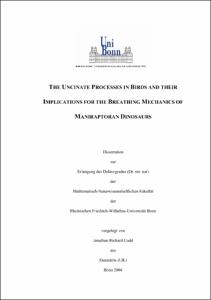The Uncinate Processes in Birds and their Implications for the Breathing Mechanics of Maniraptoran Dinosaurs

The Uncinate Processes in Birds and their Implications for the Breathing Mechanics of Maniraptoran Dinosaurs

| dc.contributor.advisor | Perry, Steven F. | |
| dc.contributor.author | Codd, Jonathan Richard | |
| dc.date.accessioned | 2020-04-06T21:07:27Z | |
| dc.date.available | 2020-04-06T21:07:27Z | |
| dc.date.issued | 2004 | |
| dc.identifier.uri | https://hdl.handle.net/20.500.11811/2085 | |
| dc.description.abstract | The breathing mechanics of dinosaurs and the connected implications for lung structure (Perry 1983) and metabolism is currently a focus of intense and sometimes controversial discussion (Perry in press). Rubens et al (1997) have proposed a hepatic piston model for breathing in dinosaurs, where the liver is pulled back during inspiration, in a similar manner to what is found in crocodilians. However this hepatic piston model has attracted substantial criticism due to the implication that the evolution of an air-sac system, similar to that found in birds, would be impossible. However, the presence of an air-sac system in dinosaurs can be hypothesized from a phylogenetic viewpoint, as birds are the sister group of some Theropod dinosaurs, the Dromaeosaurs. In a sense birds can be seen as the surviving theropods and as such all questions on breathing and physiology of dinosaurs must be viewed against a background of the evolutionary transition from some dinosaurs to birds. The uncinate processes on the thoracic ribs are one of the most important osteological characters, which can be used to gain insight into breathing. Osteological characters are important as they allow for direct comparison with the fossil record. Uncinate processes are generally viewed as a character specific to birds, however this name is also used for some cartilaginous rib appendices of extant Lepodosaurs (Sphenadon) as well as some Crocodylia. This is despite the fact that little or nothing is known about the homology of these rib appendices. Despite the wide interest in the presence or absence of uncinate processes only one hypothesis (Zimmer 1935), based on a two dimensional model, exists which seeks to make any prediction about the possible role and function these processes may have in breathing. The length of the uncinate processes does not vary phylogenetically but with the locomoter mode of the birds. Electromyographic experiments confirmed that the associated appendicocostalis muscle was active during inspiration while the process itself may act as a brace for the attachment of the external oblique muscle which is active during expiration. Uncinate processes are an integral component of the breathing mechanics in birds. The uncinate processes of birds and maniraptoran dinosaurs are not homologous. | en |
| dc.description.abstract | Die Hakenfortsätze der Vögel und ihre Bedeutung für die Atmungsmechanik der maniraptoren Dinosaurier Die Atmungsmechanismen der Dinosaurier und die damit verbundenen Implikationen für Lungenstruktur (Perry 1983) und Stoffwechselrate sind heute Brennpunkt intensiver und oft kontroverser Diskussion (Perry im Druck). Ruben et al. (1977) schlugen für Dinosaurier das Leberkolbenmodell vor, wobei die Leber wie beim Krokodil während der Einatmung zurückgezogen wird. Gerade dieses Modell wurde jedoch stark kritisiert, weil es die Evolution eines Luftsacksystems wie das der Vögel ausschließt. Luftsäcke sind aber für die Dromaeosaurier auf Grund ihrer phylogenetischen Position als Schwestergruppe der Vögel zu erwarten. Vögel können gewisser Massen als die letzten überlebende Theropoden angesehen werden und deswegen müssen alle Fragen über die Atmung und Physiologie der Dinosaurier vor dem Hintergrund des evolutiven Übergangs zwischen Dinosaurier und Vögel betrachtet werden. Die Hakenfortsätze der thorakalen Rippen stellen eine der wichtgsten osteologischen Merkmale dar und können verwendet werden, um Aufschluß über Atmung zu bekommen. Osteologische Merkmale sind deswegen wichtig, weil sie einen direkten Vergleich mit dem Fossilbericht erlauben. Hakenfortsätze gelten im allgemeinen als vogelspezifische Merkmale. Der Name wird allerdings auch für knorplige Fortsätze an den Rippen von einem heute noch lebenden Lepidosauier (Sphenodon) und von Krokodilen benutzt, obwohl so gut wie nichts über die Homologie dieser Strukturen bekannt ist. Trotz des Interesses über das Vorkommen von Hakenfortsätzen existiert eine einzige Hypothese (Zimmer, 1935), die auf Grund eines zweidimensionalen Modells eine Erklärung der Funktion im Bezug auf die Atmung liefert. Die Länge eines Hakenfortsatzes steht in keiner Beziehung zur phylogenetischen Stellung der Gruppe, sondern ist mit der Art der Fortbewegung korreliert. Elektromyographische Untersuchungen bestätigten, daß die mm. appendicocostales während der Einatmung aktiv sind und, daß der Fortsatz selber als Ansatzstelle des für die Ausatmung wichtige m. obliquus externus dient. Hakenfortsätze sind wichtige Bestandteile der Atmungsmechanik der Vögel. Die Hakenfortsätze der Vögel sind mit denjenigen der maniraptoren Dinosaurier nicht homolog. | en |
| dc.language.iso | eng | |
| dc.rights | In Copyright | |
| dc.rights.uri | http://rightsstatements.org/vocab/InC/1.0/ | |
| dc.subject | Hakenfortsätze | |
| dc.subject | Vögel | |
| dc.subject | manraptore Dinosaurier | |
| dc.subject | Phylogenie | |
| dc.subject | Morphologie | |
| dc.subject | Elektromyographie | |
| dc.subject | uncinate process | |
| dc.subject | birds | |
| dc.subject | maniraptoran dinosaurs phylogeny | |
| dc.subject | morphology | |
| dc.subject | electromyography | |
| dc.subject.ddc | 560 Paläontologie | |
| dc.subject.ddc | 570 Biowissenschaften, Biologie | |
| dc.subject.ddc | 590 Tiere (Zoologie) | |
| dc.title | The Uncinate Processes in Birds and their Implications for the Breathing Mechanics of Maniraptoran Dinosaurs | |
| dc.type | Dissertation oder Habilitation | |
| dc.publisher.name | Universitäts- und Landesbibliothek Bonn | |
| dc.publisher.location | Bonn | |
| dc.rights.accessRights | openAccess | |
| dc.identifier.urn | https://nbn-resolving.org/urn:nbn:de:hbz:5N-04241 | |
| ulbbn.pubtype | Erstveröffentlichung | |
| ulbbnediss.affiliation.name | Rheinische Friedrich-Wilhelms-Universität Bonn | |
| ulbbnediss.affiliation.location | Bonn | |
| ulbbnediss.thesis.level | Dissertation | |
| ulbbnediss.dissID | 424 | |
| ulbbnediss.date.accepted | 13.10.2004 | |
| ulbbnediss.fakultaet | Mathematisch-Naturwissenschaftliche Fakultät | |
| dc.contributor.coReferee | Sander, Martin P. |
Files in this item
This item appears in the following Collection(s)
-
E-Dissertationen (4337)




